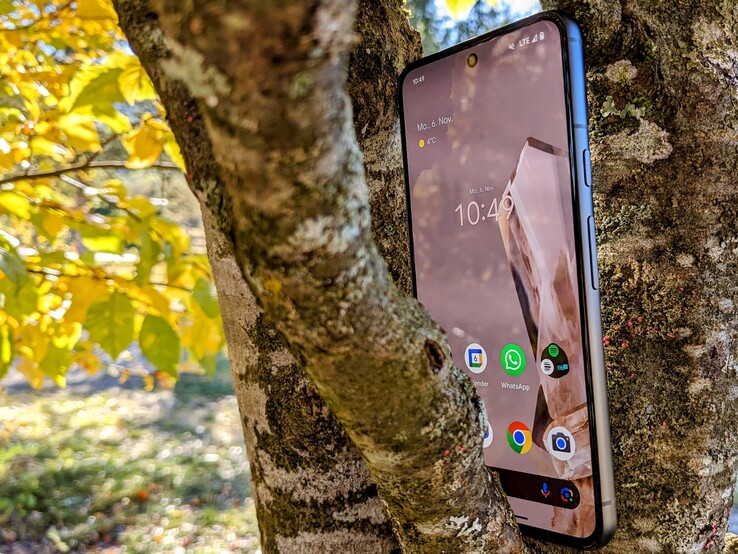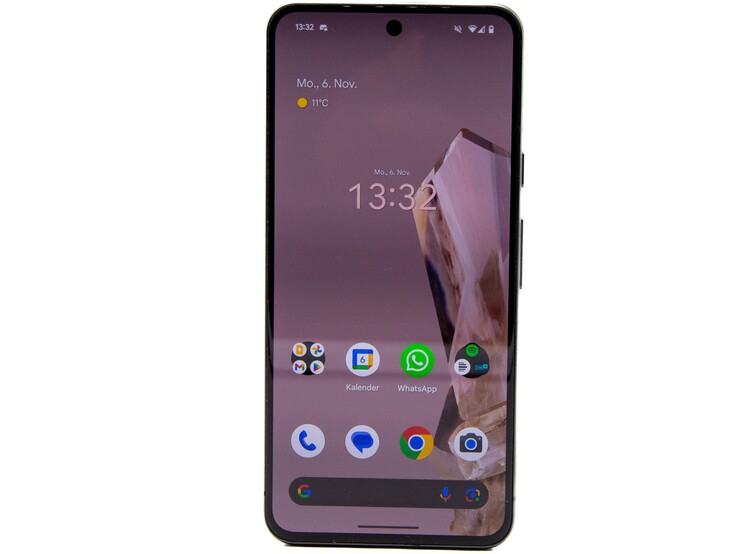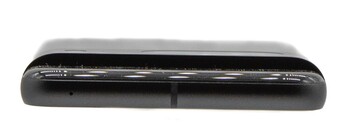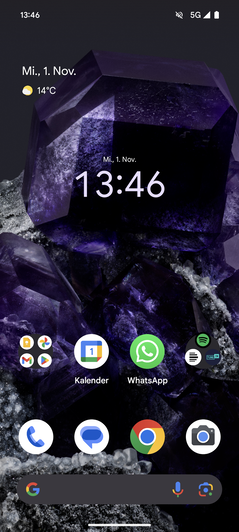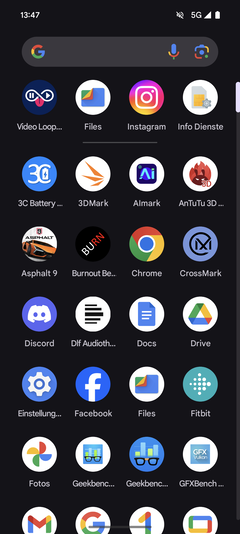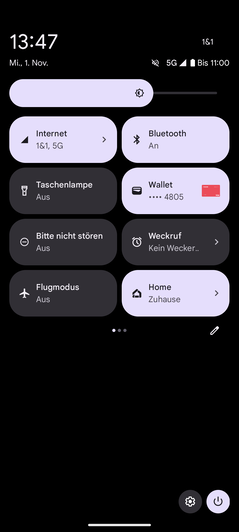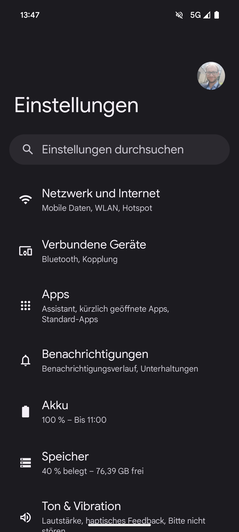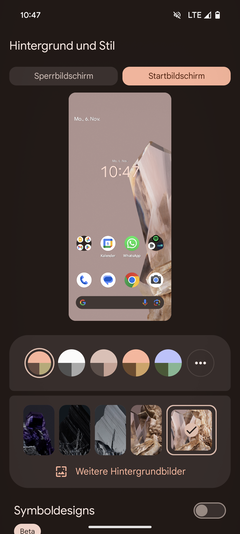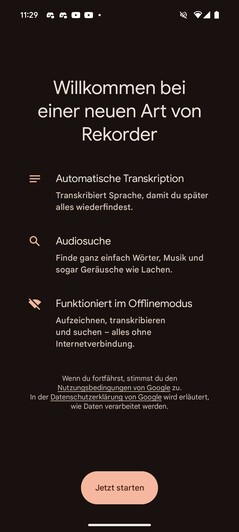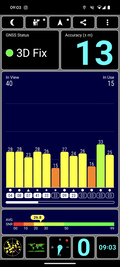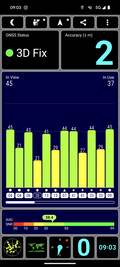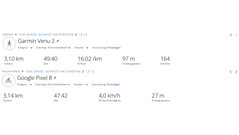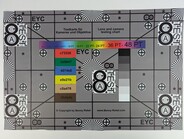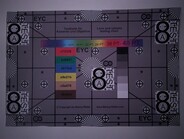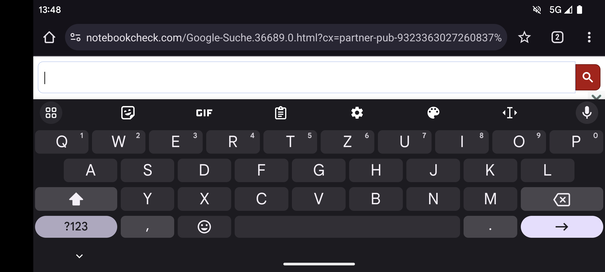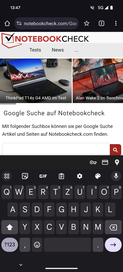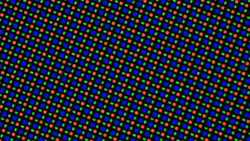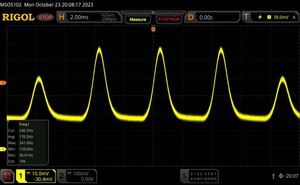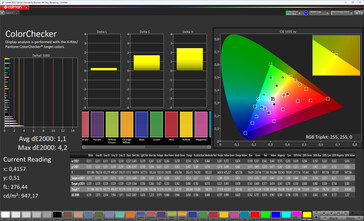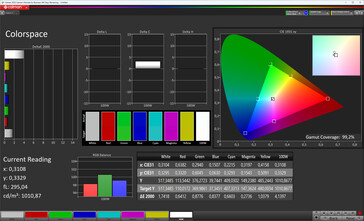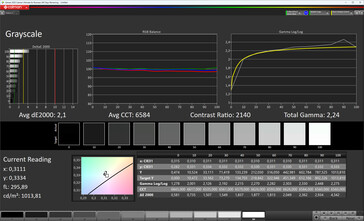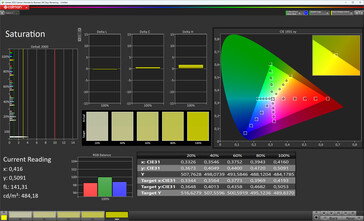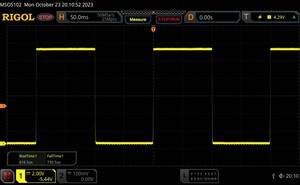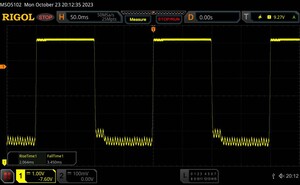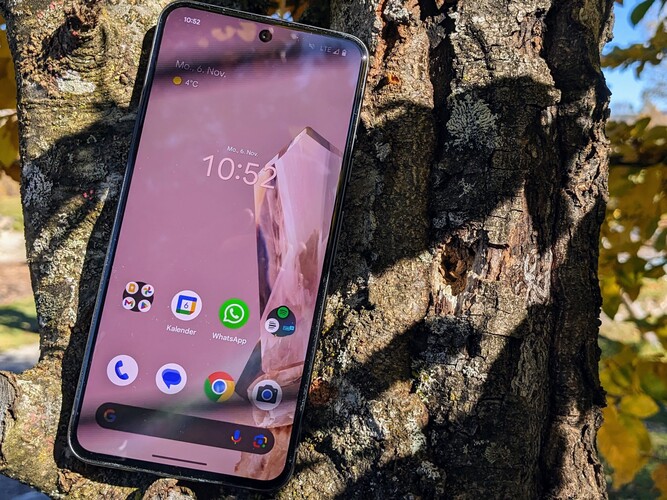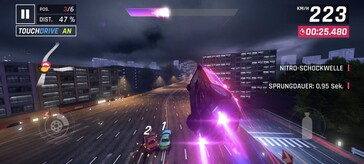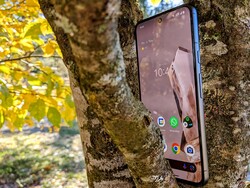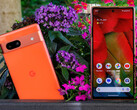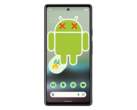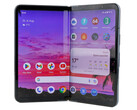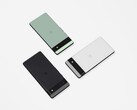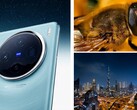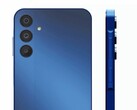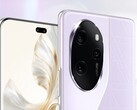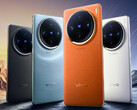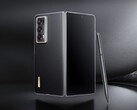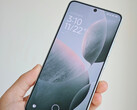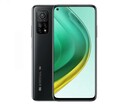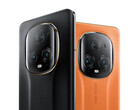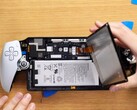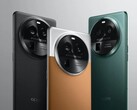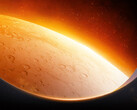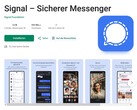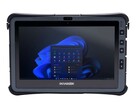Google Pixel 8 smartphone review: Compact and with 7 years of updates
Google is continuing the tradition of Pixel devices and sticking to the two-device tactic: alongside the normal Pixel 8, the manufacturer also offers a Pixel 8 Pro with a larger battery, larger display and a zoom camera. For the normal Pixel 8, Google relies on form factor and makes the device much more compact. A special feature of the current Pixel series is the extended update support: the manufacturer plans to provide the devices with new software for 7 years.
Google offers the Pixel 8 in three different colors: Hazel (gray), Obsidian (black) and Rose (pink). The smartphone is available with 128 or 256 GB of storage space. Our test unit is black and has 128 GB.
Possible competitors in comparison
Rating | Date | Model | Weight | Drive | Size | Resolution | Price |
|---|---|---|---|---|---|---|---|
| 88.9 % v7 (old) | 11 / 2023 | Google Pixel 8 Tensor G3, Mali-G715 MP7 | 187 g | 128 GB UFS 3.1 Flash | 6.20" | 2400x1080 | |
| 88.5 % v7 (old) | 11 / 2022 | Google Pixel 7 Tensor G2, Mali-G710 MP7 | 197 g | 128 GB UFS 3.1 Flash | 6.30" | 2400x1080 | |
| 89.1 % v7 (old) | 10 / 2023 | Apple iPhone 15 A16, A16 GPU 5-Core | 171 g | 128 GB NVMe | 6.10" | 2556x1179 | |
| 89.1 % v7 (old) | 02 / 2023 | Xiaomi 13 SD 8 Gen 2, Adreno 740 | 189 g | 256 GB UFS 4.0 Flash | 6.36" | 2400x1080 | |
| 86.8 % v7 (old) | 07 / 2023 | Motorola Edge 40 Dimensity 8020, Mali-G77 MP9 | 171 g | 256 GB UFS 3.1 Flash | 6.55" | 2400x1080 | |
| 90.5 % v7 (old) | 03 / 2023 | Samsung Galaxy S23 SD 8 Gen 2 for Galaxy, Adreno 740 | 167 g | 128 GB UFS 3.1 Flash | 6.10" | 2340x1080 |
Case - Compact Pixel 8 with Gorilla Glass Victus
Google has chosen a matte metal frame for the Pixel 8, which is divided by antenna strips. Gorilla Glass Victus is used on the front and back. The display edges are even and pleasantly thin. The Pixel 8 is IP68-protected against ingresses of dust and water.
The cameras are housed in the Pixel-typical bar that clearly protrudes from the device. The fact that the camera bar extends across the entire width of the device means that the device does not wobble when placed on a table. The glass has a glossy finish and is susceptible to fingerprints, and a lot of dust also collects on the camera hump.
Torsional rigidity is very good, but the device can be easily compressed. This impression is reinforced by the fact that the device sounds slightly hollow when inputs are made on the display. The buttons have the typical pixel arrangement and the power button is located above the volume rocker. The keys have a good pressure point, but are also slightly loose.
Equipment - Pixel 8 with NFC and dual SIM
Google uses its own SoC in the Pixel 8, the Tensor G3. The smartphone supports NFC and has dual SIM. A physical SIM card can be inserted and an eSIM can be stored. The storage space is not expandable. The manufacturer installs a USB-C 3.2 Gen 1 port that supports the exFAT format, but not NTFS. This means no image output is possible.
In our copy test with the Samsung 980 Pro in an Asus ROG Strix Arion case, the Pixel 8 achieved a maximum speed of 102.15 MB/s. So the speed of the USB port is rather slow.
Software - Google promises 7 years of updates
The Pixel 8 ships with Android 14. Google supplies the device exclusively with its own apps, so the system is quite lean and only 14 GB is occupied ex works. Vanilla Android is expanded with some Pixel features and apps, such as the Pixel Recorder, which can transcribe automatically. Keywords can be used to search for recordings. Automatic call answering with the Google Assistant is also a Pixel-exclusive feature.
These functions aside, there is also the option of customizing the look of Android with "Material You". The most significant software aspect is Google's new, seven-year update promise, which includes both version and security updates. In addition, Google will continue to deliver "feature drops" that add new functions to Pixel devices.
Communication and GNSS - Pixel 8 with WiFi 7
The Pixel 8 is also future-proof in terms of wireless standards, as it supports WiFi 7. Transfer rates in conjunction with our Asus ROG Rapture GT-AXE11000 reference router are stable and roughly at the same level as the predecessor and so at a standard class level. Only the Samsung Galaxy S23 clearly stands out in the 5 GHz range.
When it comes to mobile communications, the Pixel 8 naturally supports 5G. The frequency coverage is very good. The Pixel 8 supports 27 LTE and 21 5G bands, so global cellular coverage is no issue. The device's reception is unremarkable in everyday use. The Pixel 8 supports dual SIM, either in the form of a physical and an eSIM, or two eSIMs. WiFi telephony and VoLTE are also possible on the Pixel 8.
| Networking | |
| Google Pixel 8 | |
| iperf3 receive AXE11000 | |
| iperf3 transmit AXE11000 | |
| iperf3 transmit AXE11000 6GHz | |
| iperf3 receive AXE11000 6GHz | |
| Google Pixel 7 | |
| iperf3 receive AXE11000 | |
| iperf3 transmit AXE11000 | |
| iperf3 transmit AXE11000 6GHz | |
| iperf3 receive AXE11000 6GHz | |
| Apple iPhone 15 | |
| iperf3 receive AXE11000 | |
| iperf3 transmit AXE11000 | |
| Xiaomi 13 | |
| iperf3 receive AXE11000 | |
| iperf3 transmit AXE11000 | |
| iperf3 transmit AXE11000 6GHz | |
| iperf3 receive AXE11000 6GHz | |
| Motorola Edge 40 | |
| iperf3 receive AXE11000 | |
| iperf3 transmit AXE11000 | |
| Samsung Galaxy S23 | |
| iperf3 receive AXE11000 | |
| iperf3 transmit AXE11000 | |
| iperf3 transmit AXE11000 6GHz | |
| iperf3 receive AXE11000 6GHz | |
| Average of class Smartphone | |
| iperf3 receive AXE11000 | |
| iperf3 transmit AXE11000 | |
| iperf3 transmit AXE11000 6GHz | |
| iperf3 receive AXE11000 6GHz | |
The Google Pixel 8 supports all common satellite systems. However, localization indoors takes a few seconds and is not particularly precise. Outdoors, this is much quicker. We also took the Google Pixel 8 on a tour with a Garmin Venu 2 for comparison purposes. The smartphone's tracking capabilities are convincing for the most part. In some areas, however, the recorded route does not match the route on the stored map. In everyday use, navigation with Google Maps, for example, works without issue.
Telephony and Voice Quality - Crystal clear communication on the Pixel 8
Google uses its own phone app for the Pixel 8. The software is clearly structured and causes no confusion. We really like the voice quality. Both the Pixel user and the conversation partner have clear transmission without background noise. The smartphone is sufficiently loud at all times and filters out background noise well. With the “Crystal Clear Calls” function, Google improves on the smartphone's already good noise filtering capabilities.
Calls via loudspeaker are also of good quality. Although switching is noticeable, voice quality remains good. At high volumes, the frame of the smartphone vibrates noticeably.
Cameras - Normal Pixel 8 without zoom lens
The cameras are traditionally a strength of Pixel smartphones. The Pixel 8 continues this tradition and delivers impressive results. Some of the images are heavily processed by Google's software, giving them a high dynamic range and strong contrast.
Google equips the Pixel 8 with a 50 MP main camera and a 12 MP ultra-wide-angle lens. The setup corresponds to that of its predecessor, the Pixel 7. Only the Pixel 8 Pro gets the new 48 MP ultra-wide-angle camera. Nevertheless, the shots from the ultra-wide-angle camera are also pleasing; the sharpness decreases slightly towards the peripheral areas.
Unlike the Pixel 8 Pro, the normal Pixel 8 does not have a zoom lens; the zoom is only implemented digitally. This works well at 2x magnification, but at 5x magnification the images are heavily overdone and image noise is visible. More than 8x zoom is not possible.
The smartphone has a macro mode, which is activated by default. If the software detects a close object in front of the camera, it automatically kicks in. This enables clear shots from short distances. The smartphone uses the ultra wide-angle camera for this, with a slightly different color balance to the main camera. There are also special modes for long exposure, for photos of moving objects and night shots. The Pixel 8 does not offer a pro or manual mode, although it is possible to set the white balance manually.
Photos taken by the selfie camera are pleasing and the portrait mode also works very reliably. However, the resolution is quite low at 10.5 MP. Long exposure and action photos are also possible with the front camera.
Video recordings are possible with all cameras at a maximum of 4K and 60 FPS. The Pixel 8 also supports 10-bit HDR recording. The video quality of the 4K recordings is pleasing. Video stabilization and autofocus work reliably, and audio recording is also good. In HDR videos, the image is slightly distorted when panning.
Google provides additional video options such as a panning mode with better stabilization, videos with a blurred background (24 FPS), slow motion and time lapse. The smartphone gets noticeably warm on the back when filming.
One new feature is Google's "Magic Editor", which allows images to be edited afterwards with the help of AI. The range of functions extends from removing an object, adjusting the color of the sky, to stylizing or abstracting an image. Not all functions are possible in all images; in some cases the software has to suggest the function itself. However, the images have to be saved in the cloud for editing and the program also takes its time here. Post-editing results can differ greatly: sometimes the software produces impressive results, other times the images are unusable.
Image comparison
Choose a scene and navigate within the first image. One click changes the position on touchscreens. One click on the zoomed-in image opens the original in a new window. The first image shows the scaled photograph of the test device.
Plush toy rabbitLakeUltra wide angle5x zoomLow lightNo major surprises are in store when it comes to the Pixel camera's color accuracy. The biggest deviation is in white, which is displayed too warmly. Image sharpness is very good, even in the peripheral areas. Photos taken in controlled low light (1 lux) are also impressive. Colors and shapes are very easy to recognize, but the sharpness decreases.
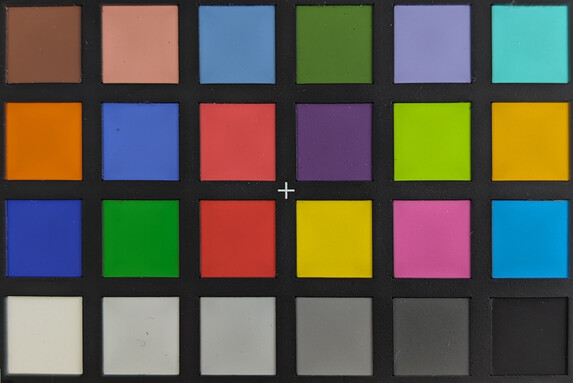
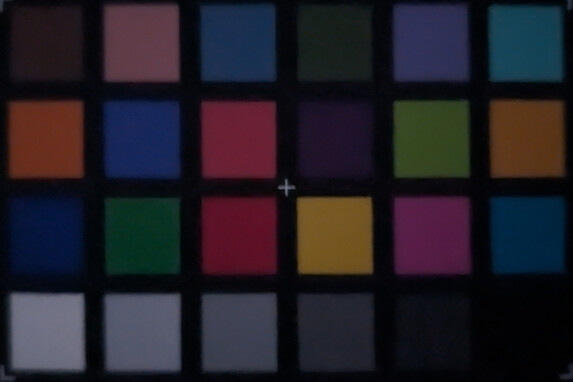
Accessories and warranty - Google also saves on the power supply unit
The scope of delivery of the Google Pixel 8 is quite straightforward. In addition to the smartphone, the packaging only contains a USB cable (USB-C to USB-C) and a USB-A to USB-C adapter. The power adapter or case have to be ordered separately.
Google offers a 24-month warranty on the Pixel 8 in Germany, which may differ in other countries. No extended warranty is available. On the other hand, spare parts will be available for seven years. Google offers various cases for the smartphone in its own store.
Input devices & operation - Pixel finger scanner without problems
Google uses its own GBoard keyboard for the Pixel 8. This means that entries can be made reliably and without errors in both portrait and landscape mode. The smartphone's screen generally impresses with good gliding properties. However, inputs in the corners - when gaming for example - are not always directly implemented.
The smartphone can be unlocked using an optical fingerprint in the display or 2D facial recognition. Both work quickly and reliably. When testing the Pixel 8, we did not have any of the problems that previous Pixel generations had with the fingerprint scanner in the display. Facial recognition can be activated by holding the device upright and the lock screen can be skipped if desired.
Display - Top brightness on the Pixel 8
Google has given the Pixel 8 a higher refresh rate of 120 Hz. However, this is not an LTPO display; the panel can only display content at 60 or 120 Hz.
The 6.2-inch OLED panel shines at maximum brightness. We measured an average brightness of 1410 cd/m² and a maximum of 1930 nits when viewing HDR content, so the smartphone almost reaches the 2000 cd/m² advertised by Google. These values were all achieved with the brightness sensor activated. Without the sensor, we reach a maximum of 1024 nits.
The panel's resolution is 428 ppi and content is displayed sharply at all times. The black level and contrast are perfect. However, we also noticed screen flickering in our measurements: the average frequency is 170 Hz. The minimum flicker is 120 Hz and the maximum 240 Hz. The Pixel 8 supports HDR10, HDR10+ and HLG.
| |||||||||||||||||||||||||
Brightness Distribution: 92 %
Center on Battery: 1450 cd/m²
Contrast: ∞:1 (Black: 0 cd/m²)
ΔE ColorChecker Calman: 1.1 | ∀{0.5-29.43 Ø4.78}
ΔE Greyscale Calman: 2.1 | ∀{0.09-98 Ø5}
99.2% sRGB (Calman 2D)
Gamma: 2.24
CCT: 6584 K
| Google Pixel 8 OLED, 2400x1080, 6.2" | Google Pixel 7 OLED, 2400x1080, 6.3" | Apple iPhone 15 Super Retina XDR OLED, 2556x1179, 6.1" | Xiaomi 13 OLED, 2400x1080, 6.4" | Motorola Edge 40 OLED, 2400x1080, 6.6" | Samsung Galaxy S23 Dynamic AMOLED 2x, 2340x1080, 6.1" | |
|---|---|---|---|---|---|---|
| Screen | -2% | -11% | -1% | -23% | -51% | |
| Brightness middle (cd/m²) | 1450 | 936 -35% | 1046 -28% | 1209 -17% | 1023 -29% | 1125 -22% |
| Brightness (cd/m²) | 1410 | 947 -33% | 1019 -28% | 1208 -14% | 1042 -26% | 1122 -20% |
| Brightness Distribution (%) | 92 | 95 3% | 94 2% | 98 7% | 90 -2% | 96 4% |
| Black Level * (cd/m²) | ||||||
| Colorchecker dE 2000 * | 1.1 | 1.3 -18% | 1.4 -27% | 1.2 -9% | 1.6 -45% | 3.2 -191% |
| Colorchecker dE 2000 max. * | 4.2 | 2.7 36% | 2.84 32% | 3 29% | 4.3 -2% | 4.9 -17% |
| Greyscale dE 2000 * | 2.1 | 1.4 33% | 2.4 -14% | 2.1 -0% | 2.8 -33% | 3.3 -57% |
| Gamma | 2.24 98% | 2.25 98% | 2.158 102% | 2.26 97% | 2.27 97% | 1.97 112% |
| CCT | 6584 99% | 6664 98% | 6410 101% | 6504 100% | 6457 101% | 6504 100% |
* ... smaller is better
Screen Flickering / PWM (Pulse-Width Modulation)
| Screen flickering / PWM detected | 170 Hz | ||
The display backlight flickers at 170 Hz (worst case, e.g., utilizing PWM) . The frequency of 170 Hz is relatively low, so sensitive users will likely notice flickering and experience eyestrain at the stated brightness setting and below. In comparison: 53 % of all tested devices do not use PWM to dim the display. If PWM was detected, an average of 8091 (minimum: 5 - maximum: 343500) Hz was measured. | |||
Series of measurements at a fixed zoom level and different brightness settings
Display Response Times
| ↔ Response Time Black to White | ||
|---|---|---|
| 1.35 ms ... rise ↗ and fall ↘ combined | ↗ 0.6165 ms rise | |
| ↘ 0.7305 ms fall | ||
| The screen shows very fast response rates in our tests and should be very well suited for fast-paced gaming. In comparison, all tested devices range from 0.1 (minimum) to 240 (maximum) ms. » 6 % of all devices are better. This means that the measured response time is better than the average of all tested devices (20.2 ms). | ||
| ↔ Response Time 50% Grey to 80% Grey | ||
| 5.51 ms ... rise ↗ and fall ↘ combined | ↗ 2.064 ms rise | |
| ↘ 3.45 ms fall | ||
| The screen shows very fast response rates in our tests and should be very well suited for fast-paced gaming. In comparison, all tested devices range from 0.165 (minimum) to 636 (maximum) ms. » 17 % of all devices are better. This means that the measured response time is better than the average of all tested devices (31.6 ms). | ||
Performance - Tensor G3 lags behind the Snapdragon
Google uses the latest version of its own SoC, the Tensor G3, in the Pixel 8. In the benchmarks, there is noticeable progress compared to the Tensor G2 in the Pixel 7. The Samsung Galaxy S23 und Xiaomi 13, however, are in a different league with their Snapdragon 8 Gen 2.
Only in the UL Procyon AI Inference benchmark does the Pixel 8 push ahead of the Snapdragon devices, but is beaten by the Pixel 7. The performance of the Pixel 8 is impressive in everyday use. Large applications are opened quickly and the UI runs without any stutters.
| UL Procyon AI Inference for Android - Overall Score NNAPI | |
| Google Pixel 7 | |
| Average Google Tensor G3 (25563 - 29654, n=3) | |
| Google Pixel 8 | |
| Motorola Edge 40 | |
| Average of class Smartphone (3769 - 81594, n=135, last 2 years) | |
| Samsung Galaxy S23 | |
| Xiaomi 13 | |
| Antutu v10 - Total Score | |
| Samsung Galaxy S23 | |
| Average of class Smartphone (142748 - 3269237, n=152, last 2 years) | |
| Google Pixel 8 | |
| Average Google Tensor G3 (1049981 - 1113506, n=3) | |
A similar picture emerges when it comes to GPU performance. Google installs a Mali-G715 MP7 graphics unit and the difference to the Mali-G710 MP7 from the Google Pixel 7 is only marginal in the benchmarks. In some cases, the test values of the predecessor are even slightly better.
The Xiaomi 13 and Samsung Galaxy S23 - both with Adreno 740 - are significantly better performers. The graphics unit in the Pixel 8 is not capable of ray tracing.
GFXBench (DX / GLBenchmark) 2.7: T-Rex Onscreen | 1920x1080 T-Rex Offscreen
GFXBench 3.0: on screen Manhattan Onscreen OGL | 1920x1080 1080p Manhattan Offscreen
GFXBench 3.1: on screen Manhattan ES 3.1 Onscreen | 1920x1080 Manhattan ES 3.1 Offscreen
GFXBench: on screen Car Chase Onscreen | 1920x1080 Car Chase Offscreen | on screen Aztec Ruins High Tier Onscreen | 2560x1440 Aztec Ruins High Tier Offscreen | on screen Aztec Ruins Normal Tier Onscreen | 1920x1080 Aztec Ruins Normal Tier Offscreen | 3840x2160 4K Aztec Ruins High Tier Offscreen
| 3DMark / Wild Life Extreme Unlimited | |
| Xiaomi 13 | |
| Samsung Galaxy S23 | |
| Google Pixel 8 | |
| Apple iPhone 15 | |
| Google Pixel 7 | |
| Motorola Edge 40 | |
| 3DMark / Wild Life Extreme | |
| Samsung Galaxy S23 | |
| Xiaomi 13 | |
| Google Pixel 8 | |
| Apple iPhone 15 | |
| Google Pixel 7 | |
| Motorola Edge 40 | |
| 3DMark / Wild Life Unlimited Score | |
| Xiaomi 13 | |
| Samsung Galaxy S23 | |
| Apple iPhone 15 | |
| Google Pixel 8 | |
| Google Pixel 7 | |
| Motorola Edge 40 | |
| 3DMark / Wild Life Score | |
| Google Pixel 8 | |
| Google Pixel 7 | |
| Motorola Edge 40 | |
| 3DMark / Sling Shot Extreme (Vulkan) Unlimited Physics | |
| Motorola Edge 40 | |
| 3DMark / Sling Shot Extreme (Vulkan) Unlimited Graphics | |
| Motorola Edge 40 | |
| 3DMark / Sling Shot Extreme (Vulkan) Unlimited | |
| Motorola Edge 40 | |
| 3DMark / Sling Shot Extreme (ES 3.1) Unlimited Physics | |
| Samsung Galaxy S23 | |
| Motorola Edge 40 | |
| Google Pixel 8 | |
| Xiaomi 13 | |
| Google Pixel 7 | |
| 3DMark / Sling Shot Extreme (ES 3.1) Unlimited Graphics | |
| Xiaomi 13 | |
| Samsung Galaxy S23 | |
| Google Pixel 8 | |
| Google Pixel 7 | |
| Motorola Edge 40 | |
| 3DMark / Sling Shot Extreme (ES 3.1) Unlimited | |
| Samsung Galaxy S23 | |
| Xiaomi 13 | |
| Google Pixel 8 | |
| Google Pixel 7 | |
| Motorola Edge 40 | |
| GFXBench (DX / GLBenchmark) 2.7 / T-Rex Onscreen | |
| Motorola Edge 40 | |
| Xiaomi 13 | |
| Samsung Galaxy S23 | |
| Google Pixel 8 | |
| Google Pixel 7 | |
| Apple iPhone 15 | |
| GFXBench (DX / GLBenchmark) 2.7 / T-Rex Offscreen | |
| Samsung Galaxy S23 | |
| Xiaomi 13 | |
| Apple iPhone 15 | |
| Google Pixel 8 | |
| Google Pixel 7 | |
| Motorola Edge 40 | |
| GFXBench 3.0 / Manhattan Onscreen OGL | |
| Xiaomi 13 | |
| Samsung Galaxy S23 | |
| Google Pixel 7 | |
| Google Pixel 8 | |
| Apple iPhone 15 | |
| Motorola Edge 40 | |
| GFXBench 3.0 / 1080p Manhattan Offscreen | |
| Samsung Galaxy S23 | |
| Xiaomi 13 | |
| Apple iPhone 15 | |
| Google Pixel 7 | |
| Google Pixel 8 | |
| Motorola Edge 40 | |
| GFXBench 3.1 / Manhattan ES 3.1 Onscreen | |
| Xiaomi 13 | |
| Samsung Galaxy S23 | |
| Google Pixel 7 | |
| Google Pixel 8 | |
| Apple iPhone 15 | |
| Motorola Edge 40 | |
| GFXBench 3.1 / Manhattan ES 3.1 Offscreen | |
| Samsung Galaxy S23 | |
| Xiaomi 13 | |
| Apple iPhone 15 | |
| Google Pixel 8 | |
| Google Pixel 7 | |
| Motorola Edge 40 | |
| GFXBench / Car Chase Onscreen | |
| Samsung Galaxy S23 | |
| Xiaomi 13 | |
| Google Pixel 7 | |
| Apple iPhone 15 | |
| Google Pixel 8 | |
| Motorola Edge 40 | |
| GFXBench / Car Chase Offscreen | |
| Samsung Galaxy S23 | |
| Xiaomi 13 | |
| Apple iPhone 15 | |
| Google Pixel 8 | |
| Google Pixel 7 | |
| Motorola Edge 40 | |
| GFXBench / Aztec Ruins High Tier Onscreen | |
| Samsung Galaxy S23 | |
| Xiaomi 13 | |
| Apple iPhone 15 | |
| Google Pixel 8 | |
| Google Pixel 7 | |
| Motorola Edge 40 | |
| GFXBench / Aztec Ruins High Tier Offscreen | |
| Samsung Galaxy S23 | |
| Xiaomi 13 | |
| Apple iPhone 15 | |
| Google Pixel 8 | |
| Google Pixel 7 | |
| Motorola Edge 40 | |
| GFXBench / Aztec Ruins Normal Tier Onscreen | |
| Samsung Galaxy S23 | |
| Xiaomi 13 | |
| Google Pixel 8 | |
| Google Pixel 7 | |
| Apple iPhone 15 | |
| Motorola Edge 40 | |
| GFXBench / Aztec Ruins Normal Tier Offscreen | |
| Xiaomi 13 | |
| Samsung Galaxy S23 | |
| Apple iPhone 15 | |
| Google Pixel 8 | |
| Google Pixel 7 | |
| Motorola Edge 40 | |
| GFXBench / 4K Aztec Ruins High Tier Offscreen | |
| Samsung Galaxy S23 | |
| Xiaomi 13 | |
| Apple iPhone 15 | |
| Google Pixel 8 | |
| Google Pixel 7 | |
| Motorola Edge 40 | |
The results of the browser benchmarks confirm the same picture from the previous tests: the performance of the Pixel 8 is at a good level, but Samsung Galaxy S23 and the Apple iPhone 15 are even better performers.
No issues pop up during everyday surfing. Pages load quickly. Scrolling is also wonderfully smooth thanks to the 120 Hz display.
| Jetstream 2 - 2.0 Total Score | |
| Apple iPhone 15 (Chrome 117) | |
| Samsung Galaxy S23 (Chrome 109) | |
| Average of class Smartphone (23.8 - 387, n=149, last 2 years) | |
| Xiaomi 13 (Chrome 108) | |
| Google Pixel 8 (chrome 116) | |
| Average Google Tensor G3 (94.8 - 105.2, n=3) | |
| Google Pixel 7 (Chrome 106) | |
| Motorola Edge 40 (Chrome 114.0.5735.57) | |
| Speedometer 2.0 - Result 2.0 | |
| Apple iPhone 15 (Chrome 117) | |
| Average of class Smartphone (15.2 - 643, n=122, last 2 years) | |
| Average Google Tensor G3 (136 - 161, n=3) | |
| Samsung Galaxy S23 (Chrome 109) | |
| Google Pixel 8 (chrome 116) | |
| Xiaomi 13 (Chrome 108) | |
| Google Pixel 7 (Chrome 106) | |
| Motorola Edge 40 (Chrome 114.0.5735.57) | |
| WebXPRT 4 - Overall | |
| Average of class Smartphone (27 - 306, n=145, last 2 years) | |
| Samsung Galaxy S23 (Chrome 109) | |
| Xiaomi 13 (Chrome 108) | |
| Average Google Tensor G3 (94 - 103, n=3) | |
| Google Pixel 8 (chrome 116) | |
| Google Pixel 7 (Chrome 106) | |
| Motorola Edge 40 (Chrome 114.0.5735.57) | |
| WebXPRT 3 - Overall | |
| Apple iPhone 15 (Chrome 117) | |
| Average of class Smartphone (38 - 380, n=31, last 2 years) | |
| Average Google Tensor G3 (115 - 135, n=3) | |
| Google Pixel 8 (chrome 116) | |
| Google Pixel 7 (Chrome 106) | |
| Motorola Edge 40 (Chrome 114.0.5735.57) | |
| Octane V2 - Total Score | |
| Apple iPhone 15 (Chrome 117) | |
| Samsung Galaxy S23 (Chrome 109) | |
| Average of class Smartphone (2228 - 121337, n=197, last 2 years) | |
| Average Google Tensor G3 (46738 - 49506, n=3) | |
| Google Pixel 8 (chrome 116) | |
| Google Pixel 7 | |
| Xiaomi 13 (Chrome 108) | |
| Motorola Edge 40 (Chrome 114.0.5735.57) | |
| Mozilla Kraken 1.1 - Total | |
| Motorola Edge 40 (Chrome 114.0.5735.57) | |
| Average of class Smartphone (257 - 28190, n=155, last 2 years) | |
| Google Pixel 7 (Chrome 106) | |
| Google Pixel 8 (chrome 116) | |
| Average Google Tensor G3 (840 - 998, n=3) | |
| Xiaomi 13 (Chrome 108) | |
| Samsung Galaxy S23 (Chrome 109) | |
| Apple iPhone 15 (Chrome 117) | |
* ... smaller is better
UFS 3.1 storage is installed in the Google Pixel 8. Memory expansion via microSD card is not possible. No anomalies in storage speed were observed in everyday use. Our storage benchmark does not run on Android 14 - we are working on a solution.
Games - Current titles in the highest resolution on the Pixel 8
The performance capabilities of the Google Pixel 8 are sufficient for current games such as PUBG Mobile or Asphalt 9. PUBG Mobile can be played smoothly at the Ultra HDR and Ultra framerate settings. Measuring the framerate is currently not possible because GameBench is not yet compatible with the Pixel 8 or Android 14.
Asphalt 9 has long loading times on the Pixel 8. However, once the game is open, sessions can be played smoothly and without issue.
Emissions - Google smartphone subject to little throttling
Temperature - Tensor G3 does not get too hot
The Pixel 8 gets noticeably warm under maximum load. We measured an average temperature of around 40 degrees under load. This means that the smartphone can be held at all times and remains operable.
The Pixel 8 usually remains pleasantly cool in everyday use. Only when playing games or watching movies does the device get noticeably warm without becoming uncomfortable. Not only the front and back get warm, but also the frame.
The Pixel 8 performs well in the Wild Life Stress Test Stability and the Wild Life Extreme Stress Test. The smartphone's performance is throttled, but not as much as the Pixel 7 or the Samsung Galaxy S23.
(±) The maximum temperature on the upper side is 42.7 °C / 109 F, compared to the average of 35.2 °C / 95 F, ranging from 21.9 to 247 °C for the class Smartphone.
(±) The bottom heats up to a maximum of 42.8 °C / 109 F, compared to the average of 34 °C / 93 F
(+) In idle usage, the average temperature for the upper side is 28.1 °C / 83 F, compared to the device average of 32.9 °C / 91 F.
3DMark Wild Life Stress Test
| 3DMark | |
| Wild Life Stress Test Stability | |
| Google Pixel 8 | |
| Samsung Galaxy S23 | |
| Google Pixel 7 | |
| Wild Life Extreme Stress Test | |
| Google Pixel 8 | |
| Google Pixel 7 | |
| Samsung Galaxy S23 | |
Speakers - Solid stereo sound on the Pixel 8
Google relies on stereo speakers for the Pixel 8 and the setup works very well. The lower speaker fires downwards while the upper one is integrated into the earcup. The mids in particular are reproduced very linearly, which is another improvement on the Pixel 7. However, the bass and low frequencies are rather weak, even for a smartphone.
The Pixel 8 can get loud without distorting. There is hardly any vibrating either. Although the smartphone does not have jack output, we were able to connect Bluetooth headphones without issue. The following codecs are supported: SBC, AAC, aptX, aptX HD, LDAC, LC3 and Opus.
Google Pixel 8 audio analysis
(+) | speakers can play relatively loud (89 dB)
Bass 100 - 315 Hz
(-) | nearly no bass - on average 26.8% lower than median
(+) | bass is linear (6.2% delta to prev. frequency)
Mids 400 - 2000 Hz
(+) | balanced mids - only 4.2% away from median
(+) | mids are linear (5.4% delta to prev. frequency)
Highs 2 - 16 kHz
(+) | balanced highs - only 4% away from median
(+) | highs are linear (3.3% delta to prev. frequency)
Overall 100 - 16.000 Hz
(±) | linearity of overall sound is average (16.2% difference to median)
Compared to same class
» 6% of all tested devices in this class were better, 5% similar, 90% worse
» The best had a delta of 11%, average was 35%, worst was 134%
Compared to all devices tested
» 25% of all tested devices were better, 5% similar, 69% worse
» The best had a delta of 4%, average was 24%, worst was 134%
Google Pixel 7 audio analysis
(+) | speakers can play relatively loud (88.3 dB)
Bass 100 - 315 Hz
(-) | nearly no bass - on average 27.4% lower than median
(±) | linearity of bass is average (9.5% delta to prev. frequency)
Mids 400 - 2000 Hz
(+) | balanced mids - only 3.9% away from median
(+) | mids are linear (5.6% delta to prev. frequency)
Highs 2 - 16 kHz
(±) | higher highs - on average 6.1% higher than median
(+) | highs are linear (3.9% delta to prev. frequency)
Overall 100 - 16.000 Hz
(±) | linearity of overall sound is average (18.1% difference to median)
Compared to same class
» 16% of all tested devices in this class were better, 9% similar, 75% worse
» The best had a delta of 11%, average was 35%, worst was 134%
Compared to all devices tested
» 37% of all tested devices were better, 8% similar, 55% worse
» The best had a delta of 4%, average was 24%, worst was 134%
Battery life - Better than the Pixel 7
Energy consumption - Progress in minimum consumption
The power consumption has changed compared to its predecessor, the Pixel 7. While the Pixel 8 has become more economical in idle mode, it consumes more under full load. However, we now use the Burnout benchmark for the maximum measurements, so these values are not comparable.
The Pixel devices come close in the other measured values. The Samsung Galaxy S23 is on par in terms of minimum consumption, but is significantly more economical in all other disciplines.
| Off / Standby | |
| Idle | |
| Load |
|
Key:
min: | |
| Google Pixel 8 4575 mAh | Google Pixel 7 4355 mAh | Apple iPhone 15 3349 mAh | Xiaomi 13 4500 mAh | Motorola Edge 40 4400 mAh | Samsung Galaxy S23 3900 mAh | Average Google Tensor G3 | Average of class Smartphone | |
|---|---|---|---|---|---|---|---|---|
| Power Consumption | 7% | -15% | 11% | -13% | 27% | -17% | -28% | |
| Idle Minimum * (Watt) | 0.56 | 0.89 -59% | 0.9 -61% | 0.76 -36% | 0.62 -11% | 0.57 -2% | 0.703 ? -26% | 0.845 ? -51% |
| Idle Average * (Watt) | 1.08 | 1.07 1% | 1 7% | 1.1 -2% | 1.78 -65% | 0.74 31% | 1.337 ? -24% | 1.44 ? -33% |
| Idle Maximum * (Watt) | 1.17 | 1.2 -3% | 1.1 6% | 1.13 3% | 1.85 -58% | 0.83 29% | 1.457 ? -25% | 1.625 ? -39% |
| Load Average * (Watt) | 8.01 | 3.27 59% | 6 25% | 2.99 63% | 3.02 62% | 4.26 47% | 8.14 ? -2% | 7.01 ? 12% |
| Load Maximum * (Watt) | 8.89 | 5.5 38% | 13.6 -53% | 6.63 25% | 8.23 7% | 6.16 31% | 9.42 ? -6% | 11.3 ? -27% |
* ... smaller is better
Power consumption: Geekbench (150 cd/m²)
Power consumption: GFXBench (150 cd/m²)
Battery life - Safely through the day with the Pixel 8
We subjected the Pixel 8 to various battery tests. In the everyday WiFi test, the Pixel 8 achieved a runtime of 13.5 hours, which is a significant improvement over the Pixel 7, but all other comparison devices last longer.
During video playback in a continuous loop, however, the Pixel 8 shines and takes the lead in the comparison field. The measured runtimes under full load are hardly comparable due to the switch to the Burnout benchmark.
In everyday use, the Pixel 8 gets through a day well, and even 1.5 days of use is possible if long phone calls and games are avoided. Wired charging takes place with a maximum of 30 watts. The smartphone also supports wireless charging via the Qi standard, with up to 18 watts on the Pixel Stand 2 and up to 12 watts on other Qi chargers.
The Pixel 8 recharges from 0 to 84 percent in one hour via an 18-watt Google power supply. A full charge takes 87 minutes.
| Google Pixel 8 4575 mAh | Google Pixel 7 4355 mAh | Apple iPhone 15 3349 mAh | Xiaomi 13 4500 mAh | Motorola Edge 40 4400 mAh | Samsung Galaxy S23 3900 mAh | |
|---|---|---|---|---|---|---|
| Battery runtime | -1% | 38% | 56% | 27% | 35% | |
| Reader / Idle (h) | 24.9 | 17.7 -29% | 45 81% | 49.7 100% | 37.9 52% | 37.5 51% |
| H.264 (h) | 22.7 | 20.5 -10% | 21.8 -4% | 20.4 -10% | 20.6 -9% | 20.9 -8% |
| WiFi v1.3 (h) | 13.6 | 12.2 -10% | 16.7 23% | 17 25% | 15.4 13% | 15.4 13% |
| Load (h) | 3.4 | 5 47% | 5.1 50% | 7.1 109% | 5.1 50% | 6.2 82% |
Pros
Cons
Verdic - Well-rounded overall package with update boost
Google has improved the Pixel 8 in several areas compared to its predecessor. The new Pixel shows solid innovative progress, but does not represent an evolutionary leap. The case has become smaller, making it a more compact device alongside the Pro.
The display now offers 120 Hz in the normal Pixel and is wonderfully bright. The smartphone's cameras are also impressive, taking fantastic pictures in all lighting conditions and the many new video functions are also impressive. Ultimately, the difference to the Pixel 8 Pro becomes clear when it comes to the cameras.
The new Google Tensor G3 delivers good performance, but does not reach the level of devices equipped with the Snapdragon 8 Gen 2. The same applies to the built-in graphics unit. The Pixel 8 offers more than enough performance for everyday use, but is not at the top of its price range.
A shame that Google hasn't opted for the latest UFS 4.0 storage. The USB-C port also falls short of expectations with no image output and slow transfer rates. The new AI-supported image processing leaves an ambivalent impression. The results are occasionally impressive - but not always. In addition, the images must be backed up in the cloud and the working speed has room for improvement.
More than just pure performance, the Pixel 8 is a successful smartphone overall with a very long update supply.
Google's new update promise, on the other hand, is commendable. The manufacturer intends to provide the Pixel 8 series with updates for seven years. Spare parts will also be available for this period. This could make the Pixel 8 a real long-distance runner. If the device is used for such a long time, this puts the increased price (compared to its predecessor) into perspective.
The Samsung Galaxy S23 is a little more powerful and also offers good updates. The Motorola Edge 40 is significantly cheaper and also comes with stock Android.
Price and availability
The 128 GB variant of the Google Pixel 8 is currently available at discounted Black Friday prices on Amazon for US$549.49 in Rose, Obsidian or Hazel. Best Buy also has the same offer for the same variant, namely $549.49 in Rose, Obsidian or Hazel. The 256 GB variant is also discounted at $609.00 (Rose, Obsidian or Hazel).
Prices are as of 18.11.2023 and are subject to change.
Google Pixel 8
- 11/14/2023 v7 (old)
Benedikt Winkel
Transparency
The selection of devices to be reviewed is made by our editorial team. The test sample was given to the author by the manufacturer free of charge for the purposes of review. There was no third-party influence on this review, nor did the manufacturer receive a copy of this review before publication. There was no obligation to publish this review. As an independent media company, Notebookcheck is not subjected to the authority of manufacturers, retailers or publishers.
This is how Notebookcheck is testing
Every year, Notebookcheck independently reviews hundreds of laptops and smartphones using standardized procedures to ensure that all results are comparable. We have continuously developed our test methods for around 20 years and set industry standards in the process. In our test labs, high-quality measuring equipment is utilized by experienced technicians and editors. These tests involve a multi-stage validation process. Our complex rating system is based on hundreds of well-founded measurements and benchmarks, which maintains objectivity. Further information on our test methods can be found here.




